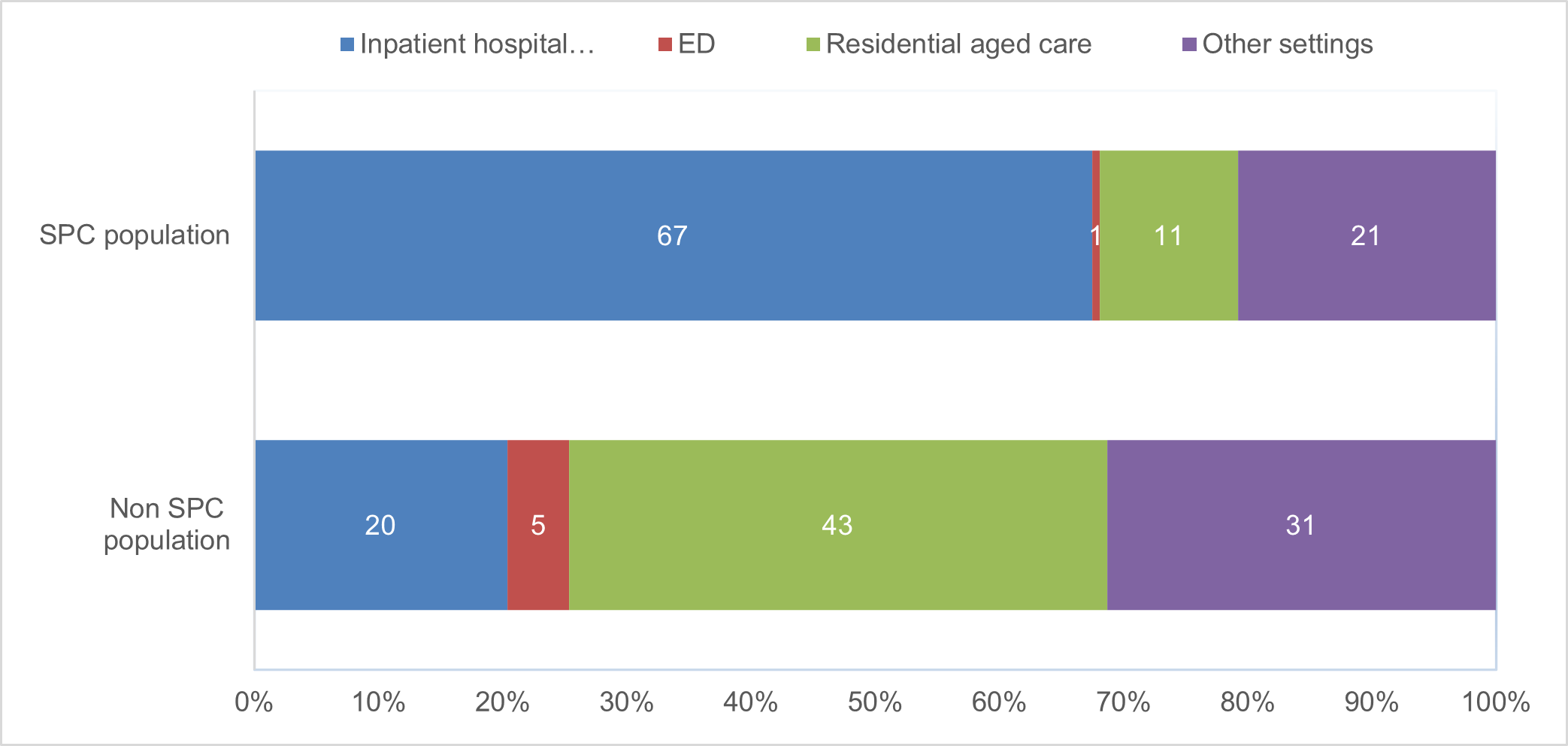Place of death
Hospital is the most common place of death for the SPC population, while residential aged care is the most common place of death for the non-SPC population
At the time of death, over 2 in 3 (67%) of the SPC population were an admitted patient, 11% were in residential aged care, 0.6% were in ED and 21% were in other settings. This pattern differs considerably for the population not receiving SPC as shown in Figure 3.13, where residential aged care was the most common place of death (43%), followed by other community settings (31%) and inpatient care (20%).
These differences in place of death for the SPC and non-SPC populations are consistent with the finding that 56% of those who received any hospital inpatient SPC service last received this in their last week of life, and therefore likely that they were in hospital at the time of death (see Care Provision for further details).
Figure 3.13: Place of death, for the SPC and non-SPC populations

Source: Supplementary Tables 2a, 2c.
Over 4 in 5 dementia deaths occur in residential aged care for population not receiving SPC compared with 1 in 3 for the SPC population
People most commonly move into residential aged care when they are no longer able to live by themselves, often at an advanced age where dementia is most prevalent. This study has also highlighted the high prevalence of dementia in residential aged care as shown in Figure 3.14, with 85% of all dementia deaths occurring in residential aged care for the non-SPC population. The corresponding proportion for the SPC population was 36%, consistent with the lower receipt of SPC among people dying from dementia and aged 85 years and over (as discussed in previous sections).
When looking at other causes of death, most of these deaths occurred in inpatient hospital care for the SPC population, while for the non-SPC population these deaths were more likely to occur in ED/other settings ('ED' and 'other' combined for reasons of confidentiality).
See Supplementary Table 2 for further details on place of death characteristics by age, sex, and remoteness for the SPC and non-SPC populations.
Figure 3.14: Underlying cause of death, by place of death, for SPC and non SPC populations


Source: Supplementary Tables 2b, 2d.
1 in 5 people who died in hospital were living in residential aged care for the last year of life
People who died as an inpatient in hospital may have been transferred from residential aged care or other community settings. Looking at the transitions between these settings in the last few weeks of life provides important insights on the mix of hospital and residential aged care services used.
Of the 35,158 people in the SPC population who died in hospital, almost 1 in 5 (19%) had been in residential aged care in the last year of life, and of these, 82% had been admitted to hospital in the last week before death. Of the remaining 81% who had not been in residential aged care, 63% were admitted to hospital in their last week of life. These patterns were similar for the population not receiving SPC.
AIHW (2023) Palliative Care Services in Australia, accessed 11 October 2023.
Hui, D., Kim, S. H., Roquemore, J., Dev, R., Chisholm, G., & Bruera, E. (2014) ‘Impact of timing and setting of palliative care referral on quality of end-of-life care in cancer patients’ Cancer, doi: 10.1002/cncr.28628.
Lloyd A, Kendall M, Carduff E, Cavers D, Kimbell B and Murray S (2016) ‘Why do older people get less palliative care than younger people’, European Journal of Palliative Care, Edinburgh.
M Cardona-Morrell, JCH Kim, RM Turner, M Anstey, IA Mitchell, K Hillman (2016) ‘Non-beneficial treatments in hospital at the end of life: a systematic review on extent of the problem’, International Journal for Quality in Health Care, doi: 10.1093/intqhc/mzw060.
Meeus, F., & Brown, E. A. (2015) ‘Caring for Older Patients on Peritoneal Dialysis at End of Life’, Peritoneal dialysis international : journal of the International Society for Peritoneal Dialysis doi: 10.3747/pdi.2015.00054.
OECD (2023) Time for Better Care at the End of Life, OECD Health Policy Studies, OECD Publishing, Paris, doi: 10.1787/722b927a-en.
PCA (Palliative Care Australia) (2018). Palliative Care Service Development Guidelines. Canberra : PCA, accessed 11 October 2023.
Siouta, N., van Beek, K., Preston, N., Hasselaar, J., Hughes, S., Payne, S., Garralda, E., Centeno, C., van der Eerden, M., Groot, M., Hodiamont, F., Radbruch, L., Busa, C., Csikos, A., & Menten, J. (2016). ‘Towards integration of palliative care in patients with chronic heart failure and chronic obstructive pulmonary disease: a systematic literature review of European guidelines and pathways’ BMC palliative care, doi: 10.1186/s12904-016-0089-4.
WHO (World Health Organisation) (2020). Global Atlas of Palliative Care. London: WHO, accessed 11 October 2023.


